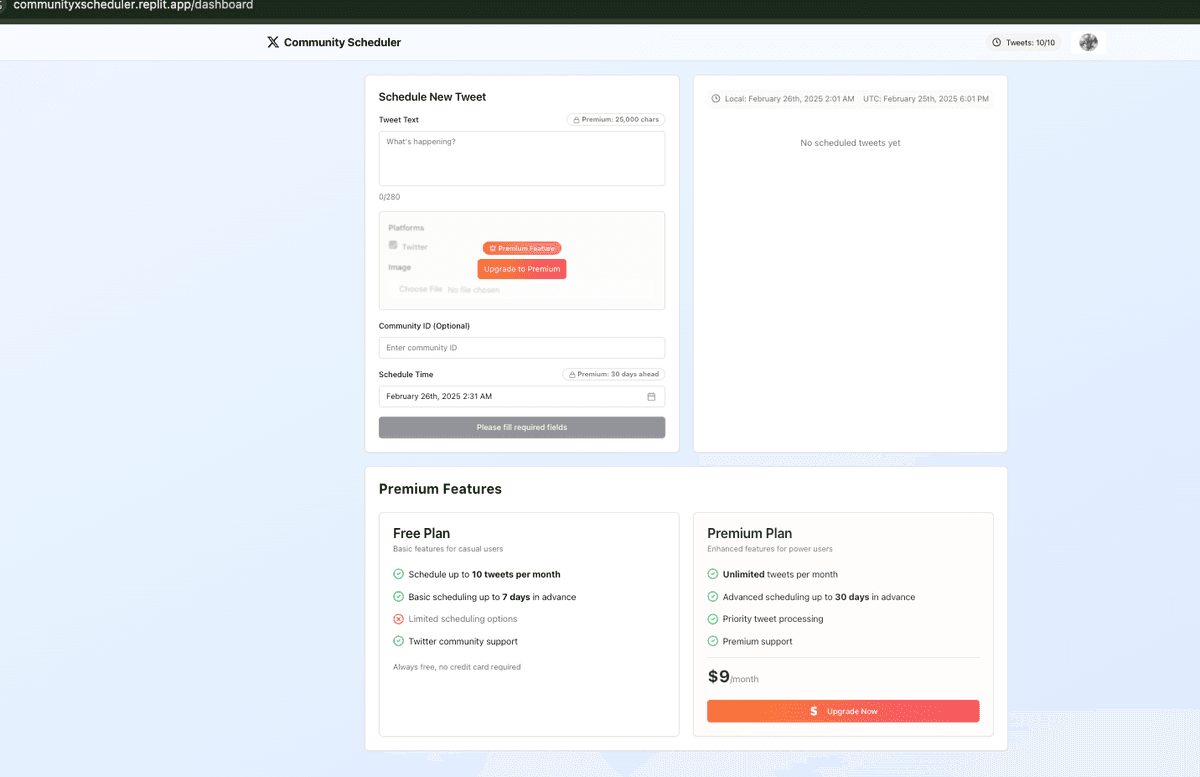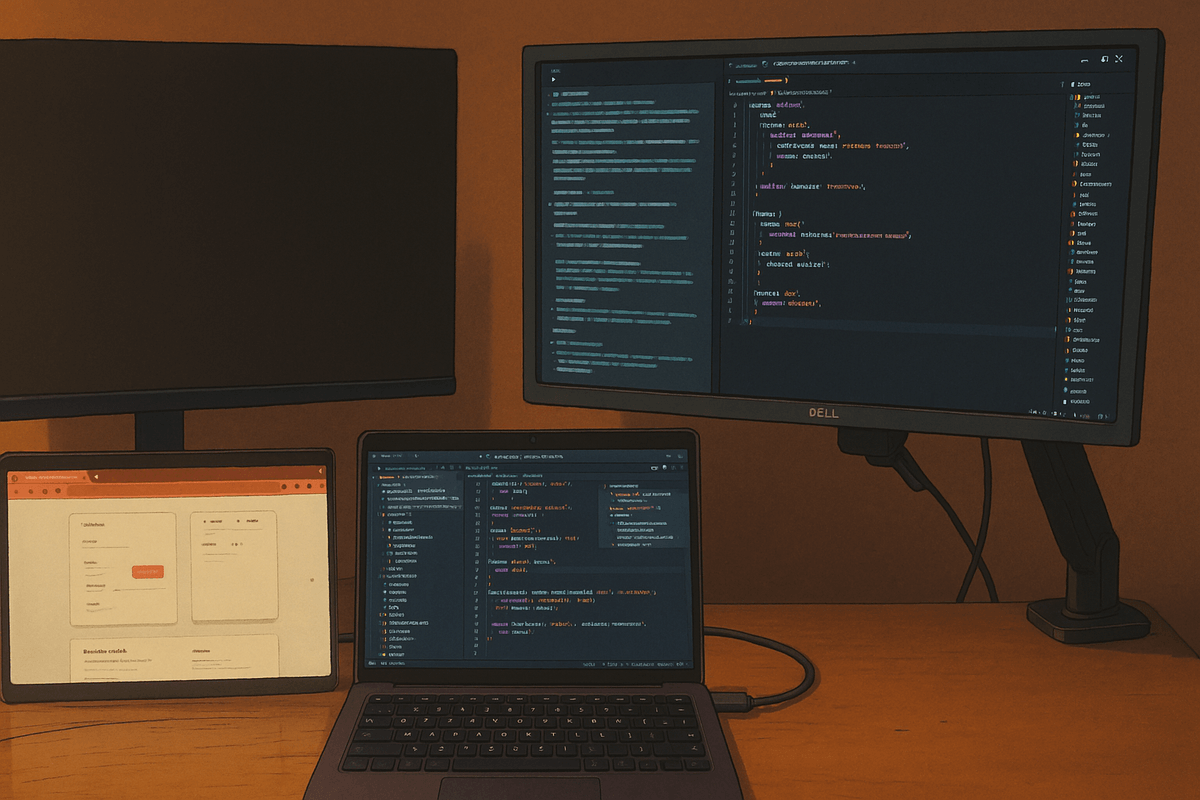What started as an innocent "overnight hackathon" has somehow morphed into a two-week development marathon. Sound familiar? I've fallen victim to feature creep once again, and I'm sharing my journey to help fellow indie hackers avoid the same trap.
When "Quick Projects" Aren't Quick Anymore
My latest adventure began with what seemed like a simple idea: a basic scheduler for X (formerly Twitter). "I'll knock this out in a night," I told myself. Yet here I am, two weeks later, still tinkering, refining, and adding "just one more feature."
In a recent conversation with my friend Mili, I realized this pattern has become all too familiar:
"I've been working on two different apps for scheduling tweets on X," I explained to him. "One's a tool I built for crypto projects to generate posts with images and schedule them. Then, for the past week, I've been tinkering with this simpler X community scheduler."
What was meant to be a quick project had already expanded into multiple tools with ever-growing feature lists.
The 80/20 Problem in Indie Development
Mili shared something that resonated deeply with me: "Seems like still the final 20% polishing and features is most difficult."
This observation hits the nail on the head. Getting to 80% completion often feels effortless and exciting. The core functionality works, the basic UI is in place, and the dopamine hits are frequent. But that final 20%—the polishing, bug fixing, deployment setup, and user testing—can feel like wading through quicksand.
The Enthusiasm Curve
"I'm trying to manage the enthusiasm level to ship the product before a new idea pulls me away," I told Mili, acknowledging my struggle with seeing projects through to completion.
His response was like looking in a mirror: "My biggest problem is personal motivation. I have enthusiasm for new projects and then I move to the next thing too fast or get bored."
This is the curse of the creative builder—we're drawn to the excitement of new ideas more than the satisfaction of finishing existing ones. I've come to realize that:
"It's been 3 years, I've coded so many projects, but none have seen the light of day."
Finding Your Sweet Spot
The key insight I've gained is understanding my own limitations and working with them rather than against them:
"I'm starting to identify, there are some projects that are too difficult that I don't attempt. There are small fun useful projects that I'm always tempted to build but won't turn into a business. I'm trying to find the sweet spot of projects that my current abilities and skillsets can achieve, and also, that current AI advancements won't limit achieving, yet can still monetize."
Breaking New Ground: Pushing to Payment Integration
This project represents a significant milestone in my journey—it's the first time I've pushed a development all the way to the payment integration stage. While the community scheduler itself is relatively small in scope, implementing Stripe has proven to be much more complex than I anticipated. There's an entire layer of business logic that you simply can't grasp until you actually attempt to monetize your product.
I had promised myself that 2024 would be the year I'd build something more substantial. Yet here I am, working on another "small utility" app. The irony isn't lost on me. But this experience has taught me that pushing a project to completion—even a modest one—reveals knowledge gaps you never knew existed.
The Coding-Marketing Imbalance
The most striking realization has been the stark imbalance in my skill set. While examining my development habits, I recalled Marc Lou's advice:
"1 hour of coding, 1 hour of marketing, 1 hour of exercising. Do these every day this year. By 2026, you'll have built a profitable side project."
Similarly, Alex Nguyen attributes his success to a disciplined approach:
"I dedicated 4 hours to coding, 4 hours to marketing, 1 hour to exercising. Did this every day for 4 months, and boom, 100K users, $25K total revenue, and $14K monthly revenue!"
When I reflect on my own routine, the pattern is clear:
Exercise? No problem. I've been training consistently for years, even preparing for marathons.
Coding? That's my comfort zone. Four, eight, sometimes even twelve hours of non-stop coding—I've done it all.
Marketing? Virtually non-existent. Despite picking up marketing freelance work to learn the ropes, I've never applied those skills to my own projects.
This imbalance explains why my technical achievements never translate to launches or users. I've been building in isolation, perfecting features for an audience that never arrives.
The Anatomy of Feature Creep: From MVP to Marathon
Looking back at my scheduler project's timeline is eye-opening:

- February 11: Hacked together a working MVP between midnight and 4 AM
- What followed was unplanned: 12 additional Replit projects exploring different tech stacks
- Extensive API testing before settling on the official X API (only to discover harsh rate limits)
- Payment integration complexities I hadn't anticipated
- Infrastructure learnings about cronjobs and database architecture that revealed Replit's cost limitations
What should have shipped in days expanded into weeks of exploration and refinement—classic feature creep.
Technical Lessons from the Trenches

Through this extended development process, I've gathered valuable insights on working with modern development tools:
- Development Environment Optimization: Configuring SSH to connect Windows Cursor to Replit was a game-changer for my workflow
- AI Tool Specialization: Each AI assistant has its strengths—Grok 3 for high-level guidance, Cursor agents for implementation, and Replit agents for configuration and deployment
- AI Limitations with Growing Codebases: As projects expand, AI tools become less reliable, often introducing new bugs by removing or conflicting with existing code
- Incremental Feature Development: Adding features one at a time with thorough testing prevents cascading failures
- Debugging Strategy: When stuck, formulating 5-7 possible scenarios, distilling to the most likely 1-2, and adding strategic logging solves most issues
- The Sleep Solution: Sometimes the best debugging technique is sleep—either your subconscious solves the problem overnight, or a new AI model releases the next day with enhanced capabilities
Moving Forward with Balance
As I (finally) wrap up my X scheduler tool and implement Stripe payments, I'm embracing a new approach to project development. The next challenge isn't technical—it's marketing what I've built and finding real users.
I'm committing to a more balanced routine that gives equal weight to building and marketing. I've already started consuming more content on marketing strategies and am preparing to apply what I've learned from my freelance work to my own projects.
Feature Creep as a Learning Journey
While feature creep extended this project far beyond my initial timeline, it inadvertently pushed me to learn crucial aspects of product development I'd previously avoided. Sometimes the long road teaches you more than the shortcut.
What I now understand is that reaching the finish line—even if the journey takes longer than planned—provides insights you simply can't gain from abandoning projects midway. Getting to payment integration revealed an entirely new dimension of product development I hadn't experienced before.
Moving Forward
Feature creep may be inevitable, but recognizing the pattern is the first step toward shipping more and abandoning less. Remember: a launched product with fewer features beats an "almost perfect" project that never sees the light of day.
The real challenge now isn't adding more features—it's having the discipline to stop coding and start marketing. That's the uncomfortable growth zone I need to step into.

